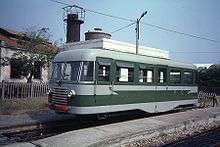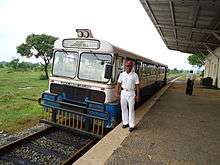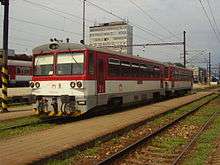Railbus



_01.jpg)

- Not to be confused with a Train-replacement bus service
A railbus is a very lightweight type passenger rail vehicle (typically non-articulated or rigid frame) that shares many aspects of its construction with a bus, usually having a bus, or modified bus, body and having four wheels on a fixed base, instead of on bogies. These railbuses, a design developed in the 1930s, have evolved into larger dimensions, performance and characteristics similar in appearance to a light railcar, and today the terms railcar and railbus are often used interchangeably.
Railbuses designed for use specifically on little-used railway lines were commonly employed in countries such as Germany, Italy, France, the United Kingdom and Sweden.[1] Today railbuses are being replaced by modern light DMU railcar designs.
British Rail railbuses
British Rail produced a variety of railbuses as a means both of building new rolling stock cheaply, and to provide services on lightly used lines economically.
A variety of railbus known as Pacers, which were constructed in the 1980s, are still in common use today, although they are being gradually replaced.
Great Northern Railway of Ireland
The Great Northern Railway of Ireland produced railbuses at the Railway Works in Dundalk.[2]
German railbuses
In Germany, the Schienenbus was developed in the 1930s to fulfill the need for an inexpensive rail vehicle built to standard specifications on Germany’s Reichsbahn (the predecessor to DB) to meet the demand for cost-effective services on light railways or Kleinbahnen, and the Wismar railbus were pioneers in those days. These were followed after the Second World War by the eventually ubiquitous Uerdingen railbuses which generally ran in pairs and were a predecessor of the modern diesel multiple units.
A number of serious accidents in Germany in the late 1970s involving Schienenbus resulted in the development and specification of larger, more robustly designed diesel railcars. Although these cars were more similar in size to the U.S. produced diesel railcars, they would not have complied with current FRA requirements, and, like their North American cousin rail diesel cars, are largely railroad-derivative designs. The DB Class 628 series exemplifies the contemporary German diesel railcar. This type of car replaced the Schienenbus and locomotive-hauled train consists where possible on branch-line and main-line assignments during the 1980s and 1990s. The Schienenbus has virtually disappeared from regular revenue service, but its rail diesel car successors are prevalent. A new-generation DMUs third in succession after the Schienenbus, are now being ordered by the hundreds by its diversity and the variety of modular design combinations.[3]
Australian railbuses
In 1937 the NSW Department of Railways added six four-wheel streamlined rail buses to serve on small branch lines in Cowra and Harden that did not have enough passengers to justify a rail motor.[4] Powered by a Ford V8 engine, they were given the designation FP1 to FP6. When the railbus service wasn't popular, several of the buses became mobile pay cars used to pay railway employees at stations and working on tracks.
In December 1941 one of these railbuses (FP 5) was destroyed when dynamite was placed on railway tracks near Yanderra. The three-man crew of the railbus were killed in the explosion. Though £2000 of loose cash was taken, the safe in the railcar could not be opened by the robbers. No one was prosecuted for the offence.[5]
The first railbus, FP1 has been restored where it is on display at New South Wales Rail Transport Museum in Thirlmere, New South Wales.
Railbus services around the world

Argentina
Locally manufactured TecnoTren railbuses are in use around Argentina, most notably on the University train of La Plata. They are mostly used in rural parts of the country where the tracks have not yet been repaired and thus can't handle the weight of regular trains.[6]
Australia
In Queensland, Australia, "RailBus service" refers to the (road) bus service running parallel to portions of some railway lines, substituting for commuter train.
Czech Republic and Slovakia

In the Czech Republic and Slovakia, railbuses are used on less frequented rural lines. Most railbuses are based on a former ČSD M 152.0 diesel multiple unit, also known as ČD/ŽSR Class 810.
India

Indian Railways operate many Railbuses and amongst it, one runs from Kolar [KOZ] to Bangarpet [BWT]. A railbus plies between Mathura and Vrindavan in Uttar Pradesh.[7]
Indonesia
On August 5, 2012 the first Batara Kresna Railbus service in Indonesia is launched to accommodate a part of commuter Prameks Train passengers from Solo to Yogyakarta City v.v through Sukoharjo.[8]
In 2014, PT Kereta Api launched railbus between Kertapati Palembang to Indralaya Ogan Ilir v.v. to ease road traffic.[9]
In 2016, Mak Buih Railbus operated by PT Kereta Api in Padang ready to serve route from Padang to Minangkabau International Airport.[10]
Japan

JNR president visited West Germany in 1953 and was introduced to railbusses there. JNR subsequently drew up a plan for railbus introduction plan in JNR, and a prototype was built in 1955. However, JNR found railbuses less reliable in daily operation as compared to standard rail equipmen and discontinued their use in the 1960s. One railbus produced Fuji Heavy Industries was operational on a minor line until the company withdrew the line from service.
Motorization soared in Japan from the 1970s on, reducing consuming passenger numbers on local private railway. Fuji Heavy Industries Ltd. in 1982 began development of an "LE-Car that incorporates significantly the structure of the bus, deficit local lines of JNR has been adopted by many of the railway company that local governments and private companies are operated by joint investment.
Sri Lanka
In areas without significant demand for regular commuter trains, such as in the Eastern province, railbus connects towns and cities. These buses were built by converting two buses originally built for road transport. Railbus between Batticaloa and Trincomalee allows passengers to travel between the two cities with fewer delays.[11]
See also
References
- ↑ Hilding Carlsson and his Railcar Company - Retrieved on 2010-04-20
- ↑ "Rail buses developed at Dundalk GNR Works - Independent.ie".
- ↑ "Transit Cooperative Research Program - Research Results Digest- September 2001—Number 43, page 27" (PDF). onlinepubs.trb.org. Retrieved 2010-05-01.
- ↑ http://www.nswrailheritage.com.au/orhprojects/cashontrack/firstfleet.htm
- ↑ http://coalstonewcastle.railpage.org.au/content/downloads/stock/files/nsw_paybus_readme.txt
- ↑ "El Tecnotren, el transporte ecológico inventado en Argentina que une pueblos". alternativa-verde.com. 4 May 2012.
- ↑ "When passengers pushed a railbus for half-a-kilometre". Hindustan Times. 31 July 2015. Retrieved July 31, 2015.
- ↑ "Railbus Batara Kresna Akhirnya Meluncur". August 5, 2012.
- ↑ "26 November, Railbus Kertalaya Kembali Beroperasi". November 23, 2014.
- ↑ http://www.irps.or.id/kunjungan-irps-sumbar-riau-ke-pt-inka-mendampingi-kadishub-sumatra-barat/
- ↑ "The Island". Eastern Province railbus project commences. 2009-07-30.
External links
![]() Media related to Railbuses at Wikimedia Commons
Media related to Railbuses at Wikimedia Commons